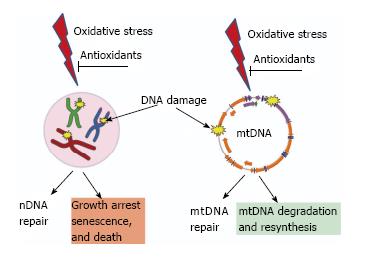Copyright
©2014 Baishideng Publishing Group Inc.
World J Exp Med. Nov 20, 2014; 4(4): 46-57
Published online Nov 20, 2014. doi: 10.5493/wjem.v4.i4.46
Published online Nov 20, 2014. doi: 10.5493/wjem.v4.i4.46
Figure 3 Consequences of unrepaired DNA damage in the nucleus and in the mitochondria.
Oxidative damage induces lesions in both nDNA (left) and mtDNA (right). Both nuclei and mitochondria possess DNA repair systems to deal with these lesions. However, cellular consequences of unrepaired damage to nDNA and mtDNA are different. While persistent damage in nDNA results in the activation of cell cycle checkpoints, growth arrest, senescence and death. In contrast, mtDNA molecules with unrepairable damage are simply degraded and new molecules are synthesized using intact molecules as templates. This figure uses Servier elements available under Creative Commons license (155).
- Citation: Shokolenko IN, Wilson GL, Alexeyev MF. Aging: A mitochondrial DNA perspective, critical analysis and an update. World J Exp Med 2014; 4(4): 46-57
- URL: https://www.wjgnet.com/2220-315X/full/v4/i4/46.htm
- DOI: https://dx.doi.org/10.5493/wjem.v4.i4.46









